This is the second in a series on straightness and its effects on the hoof.
There are many differences between the skeletons of horses and humans. One that needs to be clear in the minds of all farriers — and all riders and trainers, too — is the fact that humans have collarbones while horses lack them completely. The consequences of this difference impact every aspect of horsemanship, and that certainly includes the form and function of the equine hoof.
Differences in the shape and size of the human spine and ribcage vs. those of the horse are shown in Figure 1 (above). In humans, the shoulder joint is formed by the junction of the scapula, humerus and clavicle. The collarbones, technically called clavicles, strut between the breastbone (sternum) and the shoulder joint. The usual way of considering this anatomy is that the collarbones set the distance between the sternum in the center and the shoulder joints to either side.
Takeaways
- Since horses don’t have collarbones, nothing prevents the ribcage from migrating to the right or left side.
- In a horse that merely leans, all the connecting lines in the forelimbs will tilt in the same direction except the fetlock line. However, there is no consistent high side with the asymmetric horse.
The reason that men usually have wider shoulders than women, for example, is that their collarbones are longer. But it is equally valid to view it the other way around so that instead of going from the sternum outward, we consider the collarbones as going from the shoulder joints inward. In this sense, their function as struts becomes obvious: they brace the sternum to the center and prevent it from moving closer to either side.
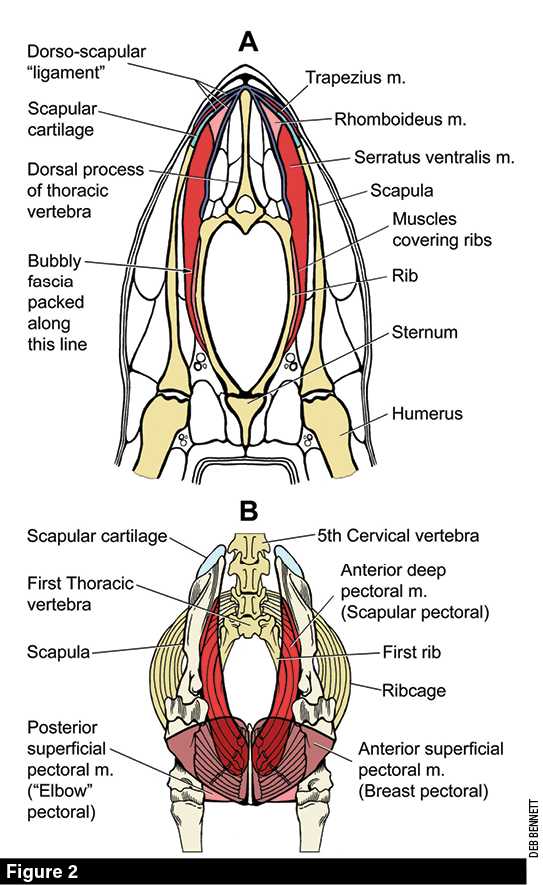
How the ventral serratus and superficial pectoral muscles join the scapulas and humeri to the ribcage and sternum. A: The cross-sectional profiles of the third thoracic vertebra, third rib, sternum, scapulas and humeri. B: Dissection view of the anterior of the ribcage, the base of the neck, scapulas, humeri and elbow joints. Note there are no collarbones.
Since horses don’t have collarbones, this function is completely lacking. There is absolutely nothing in a normal horse to prevent the sternum, and hence the entire ribcage, from migrating to the right or left side. In humans, the collarbones connect the forelimb to the sternum. In horses, this connection is entirely by means of muscles (Figure 2). In horses — because they lack collarbones — there is no bony or socketed connection between any part of the forelimb and the ribcage.
For a horse to take a step, it must unweight the hoof it intends to lift — you can’t kick a football with the leg you’re standing on. In horses, humans, or any other species, the act of unweighting is normally initiated by leaning away from the foot that is going to be picked up. In horses, when it’s the left forelimb that is to be lifted, the horse leans to the right and the ribcage shifts to the right (Figure 3).
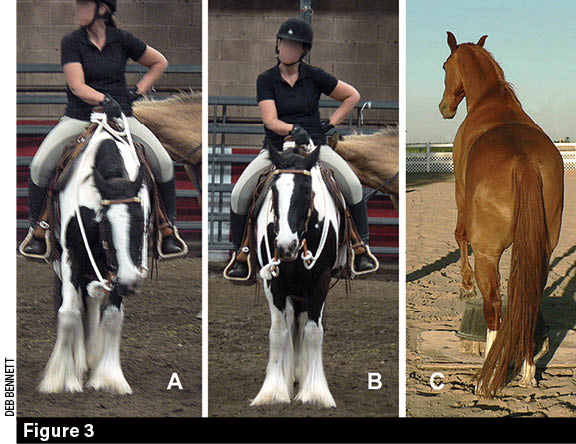
To take a step with a given forelimb, the horse must lean to the opposite side. A, B: A participant in a horsemanship clinic waits for instructions. Her horse squares itself up by breaking the right knee, lifting the foot and then placing it back on the ground. The animal’s body tilts to its left and the head swings to the opposite side. C: The author’s gelding Oliver working on the circus drum. I am directing him to lift his left leg while standing behind him to take the picture. Note how he shifts weight not only onto the right forelimb but also onto the right hind limb. At the same time, his body automatically takes on a left hand curve, i.e. ribcage concave on the left, convex on the right.
With every step a horse takes, its ribcage shifts either right or left between its forelimbs. This is why, as award-winning riding instructor Sally Swift points out,1 sitting to the trot is not primarily a matter of accommodating up-and-down motion. Instead, the rider must learn to loosen the waist to allow the seat bones and thighs to drop, first on one side and then on the other, as the horse’s body flexes left-right at the trot.
Film taken of the stallions of the Spanish Riding School from in front or above reveals that these horses look like wiggle worms when they perform at trot or passage.2 That the spine flexes in coordination with the motions of its legs at a trot is obvious to anyone who drives. It was also known to taxidermist Samuel H. Chubb, who as early as 1907 designed a photographic platform and hired a crane to lift him so he could document what the horse’s spine does at various gaits. He used the information to create fantastically lifelike skeletal mounts for the American Museum of Natural History in New York.3
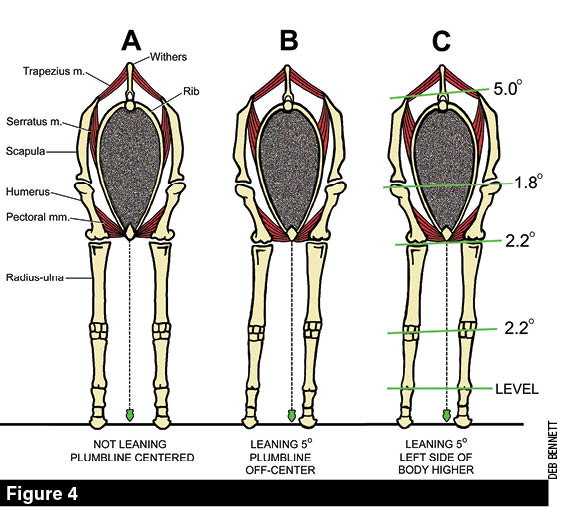
Biomechanical model of leaning showing the bones and muscles that are primarily involved. Leaning to the left shifts the ribcage to the left, so that the plumb-bob also falls closer to the left hoof. Angles of body tilt are marked by green lines in C. Slight anti-clockwise rotation of the ribcage is due to the geometry of the serratus muscles. The tilt angle at the points of shoulder is less than at top of the shoulder blades because horses typically collapse the shoulder joint on the concave side.
The anatomy shown in Figure 2 is pictured diagrammatically in Figure 4. This is a biomechanical model4 that shows how and to what extent the ribcage shifts when it leans. Seen from above, the shift in the ribcage manifests as a curve in the chain of vertebrae. In other words, what looks like leaning when the forelimbs are viewed from the front translates into curving of its spine (Figure 5). The ribcage is noticeably closer to its outside (weight-bearing) shoulder, as it also is in Figure 4C.
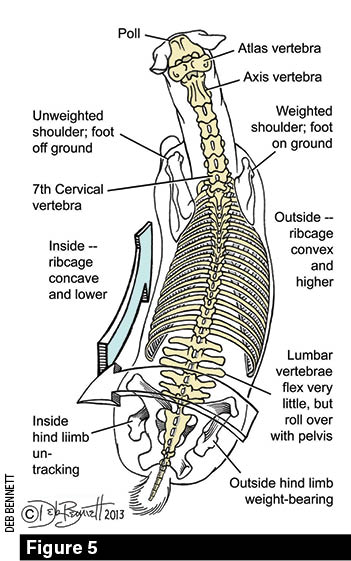
View of a horse bent “evenly” from poll to tail. An even bend is technically not possible, since the second cervical joint, the last two or three lumbar joints and the sacrum cannot bend laterally. So, when people talk about an “even” bend, they usually mean that the horse is not bent more at the base of the neck than through the ribcage. Note that there is a coupled rotation of the lumbar vertebrae and pelvis. The sort of bend that leads to suppleness is created by the horse untracking — that is stepping under the body with the inside hind leg. Horses at liberty do this volitionally, but the rider can also ask it as an exercise. We will see this image again in an upcoming installment where we explain techniques for teaching a horse to carry itself and its rider straight.
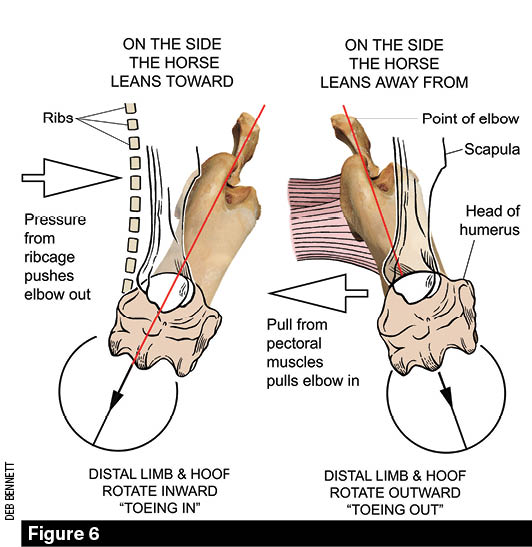
The left shoulder joint, humerus and elbow joint are seen from the top. The horse’s head is toward the bottom of the page. The sequence of ribs is shown as it looks when curving. Scapulas are shown as if transparent. The red line bisects the shaft of the humerus; as the humerus rotates, so does every structural part distal to the humerus.
Unequal Toeing-Out
Leaning/curving of the spine has further immediate consequences. Figure 6 is a view from directly above the left shoulder and arm. On the side it leans toward (the convex side), pressure from the ribcage and its overcoating of flesh and hide pushes the lower end of the humerus and elbow joint outward.
The superficial pectoral muscles (shown in Figures 2 and 7) connect the inner aspect of the shaft of the humerus, the inner surfaces of the elbow joint, and the upper part of the forearm to the sternum. When the horse leans away from the limb, the pectoral muscles on the concave side passively pull the elbow in.
As explained in the last installment, the shoulder joint can freely swivel in and out and indeed is the only joint in the forelimb that can swivel. When the elbow joint is pushed outward or pulled inward, the head of the humerus swivels. To the same degree, the forelimb distal to the shoulder joint rotates. Note that both forelimbs swivel in the same direction.
The images in Figure 6 are constructed as if for a horse in which the center-faces of the knees, the center-faces of the ankle joints, and the centerlines of the toes of the forehooves all face straight forward. In such a horse, leaning causes it to toe in on the convex side and toe out on the concave side. However, most horses don’t naturally stand with toes facing straight forward; rather, they toe out on both sides. Experienced farriers and observant horse owners notice, however, that only rarely does any horse toe out to the same degree on both sides. Instead, they typically toe out more on the concave side than the convex — and thereby hangs another chapter in our tale.
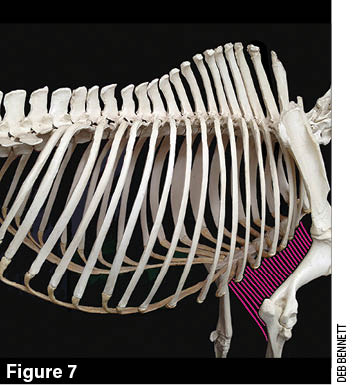
Photograph of a mounted horse skeleton taken from the side and somewhat from the rear, showing how the shoulder blade lies up against the ribcage. Pink lines represent the superficial pectoral muscles as they connect the humerus, elbow joint and upper forearm to the sternum.
Two horses with habitual toeing-out stances are shown in Figure 7. Both images are realistic because they are drawn directly from photographs.
Horse A is what I call a “left-leaning” horse. There are many causes for habitual leaning, among them eye dominance, which is the habit of approaching the handler, or any object, with the head held off to one side and thus “leading” with the dominant eye. Eye dominance is a direct reflection of the hemispheric structure of the brain and the way the optic nerves connect to the brain.
Another possible cause is that the horse’s dam had a strong preference for the foal to nurse off one teat only. The dam will permit the foal to approach and nurse on only the concave side, and from this, the foal gets into the habit of preferring the same lean/curve pattern as its dam.
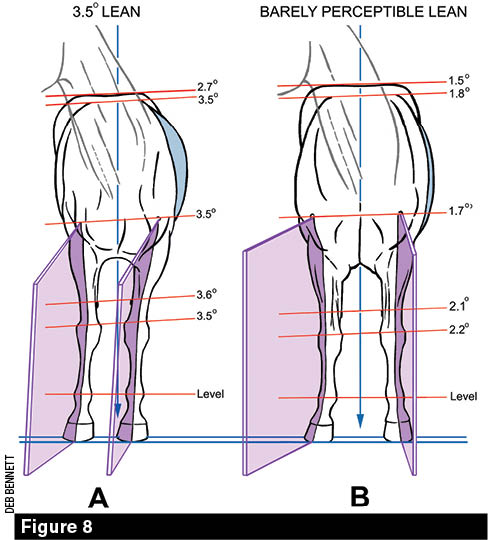
These drawings are from photographs of horses. Horse A is an example of a 3.5-degree lean, which is about as much as will be commonly seen. When lean exceeds about 5 degrees, the horse staggers and/or “crabs” when it moves. This is usually obvious to the rider. A veterinarian will suspect that it’s “neurological,” i.e. has a toxic or disease origin — as indeed it might. However, thousands of horses lean a few degrees; these animals seem subtly “off” or “grade 1 lame.” Note how leaning left causes the limb planes to rotate to the right so both forehooves face to the right. Horse B is the author’s gelding Oliver. After about 2 years of suppling exercises, his leftward lean is barely perceptible. He is as glad to work off his left hock as his right. He toes out more after suppling and straightening than Horse A because he toed out more before.
Other root causes can be adduced; the point is, however, that the cause is not structural. We are not talking about warped bones or spinal scoliosis or some sort of congenital asymmetry or deformation, nor the result of any injury, but rather the horse’s stance. So, Figure 8A shows a horse with normal structure but a leaning/curving stance.
What effect does this have on his propensity to toe out? As we have already seen, leaning/curving causes the head of the humerus on both sides to rotate at the shoulder joint. As the humeri rotate, so also rotates every part of the limbs distal to them. Therefore, a horse that if it stood without leaning would toe out equally with left and right forelimb, will toe out on the concave side more if it leans. At the same time, it will toe out on the convex side less, so that the net result is an animal whose concave-side foreleg toes out considerably while its convex-side foreleg toes approximately straight forward.
The horse shown in Figure 8B is the author’s gelding, Oliver. He came to me with as much tendency to lean as Horse 8A, and more tendency to toe out. I must use my horse as an example here so that I and my farrier can attest that he changed his habitual stance through training. We’ll return to how to correct a horse’s stance and movement — in other words, how to “make him straight” — in future installments.
My effort in training Oliver was to make him supple, which means to help him become comfortable flexing his spine equally to either side. This largely succeeded to the point where Oliver’s lean in Figure 8B is barely perceptible, and the convex side of his ribcage (marked in blue) is barely visible beyond the shoulder muscles. Note the effect that this has on his stance; he still toes out more on the right limb than the left, but there is no lean and very little height difference at the hips, top of shoulder, point of shoulder, chestnuts, knees and ankles.
Weighted and Unweighted Sides
Leaning/spinal curvature has a further important consequence: the pair of legs (one forelimb and one hind limb) that support the convex side always bear more weight than the pair on the concave side. This is due to the outward shift and curvature of the heavy ribcage and belly and is shown by the depression of the fetlock joints on the convex side.
Uneven weighting in turn is the cause of what has been called “high-low foot conformation,” which we will discuss in detail in a future installment. It's also the cause of many problems in training that look unrelated at first glance — yet they all come from leaning/curvature/preferential weighting. This realization allows us to address the horse’s training needs more effectively and appropriately, as well as its needs in terms of hoof care.
Many an old-time trainer, and many an author on horse training from the 18th century to the present, has insisted that the horse must be made straight before asking anything else of it. To make a horse straight means, as Cowboy Hall of Fame inductee and teacher Tom Dorrance used to say, to get the animal to where “it doesn’t matter to him whether he bends to the right or he bends to the left.” In other words, to supple it; to make it just as comfortable for it to bend its spine either way. This is the reason for the constant admonition to exercise the horse in both directions at the canter, and at all other gaits; and to take care to mount and handle it from both sides.
Sophisticated horsemen also learn to “call the horse’s eye,” that is to cause it to attend equally with either eye, a powerful way to reduce its tendency to lead with the preferred eye and thus its tendency to lean/curve toward that side.
Many veterinarians and professional trainers of my acquaintance have observed that most horses have a preferred hock that they habitually put more weight on. To put more weight on one hind limb means to “work off of” that limb. Over time, the habitual preference for one hock over the other results in the animal becoming more and more reluctant to use the hocks equally. I conjecture that this is due to the animal experiencing “twinges” or little pains, as well as a certain amount of stiffness, in the non-preferred hock, something like what someone who has just come out of a cast experiences.
Horses will work against a small gradient of comfort/discomfort, so it doesn’t take much to get them into a pattern of preferring one hind limb over the other and keeping them there. The bottom line is whatever other causative factors might be at play, the preference to weight one hock more than the other confirms the horse’s tendency to lean/curve in one direction.
Structural Asymmetry
Tony Gonzales was my farrier when I lived in Maryland in the 1980s. I almost always hang around when the farrier is working on my horse because there’s a chance for a good conversation in which we share experiences and observations.
Over about a year, as the concept developed in his mind, Tony introduced me to the idea that there might be horses with one front leg shorter than the other and this might be the cause for the differences in size and shape that he observed.
I thought this novel idea was such a good one that I began to look for signs of it in every horse I met. Thirty years later, I’m still adding specimens of horses with significant forelimb length differences to my collection. Specimens mean individuals, and what I’m indicating is that horses with asymmetrical structure are uncommon — I estimate fewer than 1 horse in 1,000 — certainly not the majority. To find them, I have had to search. This takes nothing away from Tony’s sharp observations or great ideas, but they have to be put in proper context.
The term “significant” needs to be defined: it means that the difference in forelimb length is outside normal limits. All mammals, of all species, are asymmetrical to some degree; this is normal. For example, one may take a photo of someone’s face, split the image in half, then reverse the right half and paste it together with the “real” right side of the face. The resulting image looks nothing like the real person because real people’s faces are not the same on the right and left sides.
The same may be said for the left and right halves of the body; rarely, for example, is a right-handed man’s left forearm or left biceps as big as the same on the right. Likewise, the left and right halves of a horse’s body are normally not identical.
“Normal limits” is the medical profession’s way of expressing population norms for measurable parameters. The norm is a range in which high and low ends are the “limits.” Normal limits are defined differently, depending on what’s being investigated, i.e. blood pressure, heart or respiratory rate, body temperature, time of teeth eruption, withers height, etc.
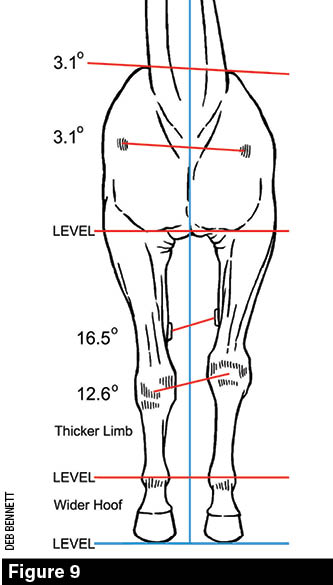
A horse with significant structural asymmetry. Note how the red lines tilt at various angles, and that some are well above 5 degrees, yet the blue centerline is plumb. The horse prefers the right pair of limbs; note the larger hoof and slightly thicker cannon bone and forearm on this side.
Normal limits for forelimb length difference are from zero to 3% averaged over specific limb segments, a figure that’s consistent across many mammal species including humans (Figure 9). If forelimbs measure within normal limits as in both Figures 8a and 8b, the difference isn’t considered significant.
Horses with significant structural asymmetry sometimes also acquire the habit of leaning and this complicates the picture. However, in my experience, the two types are not difficult to tell apart. In the asymmetric horse, the lines that connect similar points on left and right limbs, i.e. points of shoulder, elbows, chestnuts, knees and fetlock joints tilt randomly in opposite directions. In a horse that merely leans, all the connecting lines in the forelimbs tilt in the same direction except the fetlock line (because the fetlock joint of the weighted limb may be considerably depressed). In other words, there is no consistent high side in the asymmetric horse. Other red flags that indicate significant structural asymmetry include the following.
Connecting lines tilt much more than in the horse that merely leans, especially chestnut and knee lines.
The cannon bone of one limb is thicker than the other, and the hoof of that limb is larger overall.
One hoof has greater depth than the other but is neither contracted nor “club-footed.”
Other bodily asymmetries are typically present, i.e. scoliotic curvature of the spine, pseudo- or hemi-ribs, and asymmetries of the skull (i.e. one eye or point of cheek higher than the other).
Limb length differences also occur in the hind limb, but not in every case (see below).

A variety of possible presentations in rear view. Horses A and B lean; A is the same as A in Figure 8. Horse B is cow-hocked. All horses have a side preference, whether they lean or not; all of these prefer to weight the right hock. When a horse does not lean, it is either because it’s in the minority that figure out that moving and standing straight is most comfortable (Horse C); that have been suppled and thereby straightened by skillful riding (Horse D, the same animal as B in Figure 8); or that have compensated for structural asymmetry (Horse E). Despite the plumb centerline in E, it is off-center. Note the right hind hoof with much greater depth than the left. Red tilt lines vary more in rear view than in front view because the horse can compensate by flexing the stifle and/or hock of the convex side. Take a series of photos on different days or on different types of footing to get the best idea of the horse’s pattern.
Leaning vs. Structural Asymmetry in Rear View
The same rules apply in assessing the rear view. No planes are drawn into Figure 10 because drawing them would obscure other features and because by this point, I figure you can see them in your mind’s eye. Notice that the leaning picture can be complicated in the hind limb by the horse being structurally cow-hocked (or bow-legged), just as it can be complicated in the forelimb by it being knock-kneed. Figures 10A-D show some common leaning variations, contrasted with 10E, which shows a structurally asymmetrical horse.
A horse might lean in rear view as much as it leans in front view, but I haven’t seen one that leans more in the rear than in front. Further, it’s rare for a horse to lean to the right in back but to the left in front, or vice-versa. If they lean to the left in front, they also lean to the left in the rear, either to an equal degree or less so. Only in cases where there’s clinically significant pain in one hock (or in some other part of the hind limb) will the horse lean away from the pain no matter which way it leans in front.
This goes counter to the common wisdom that the horse leans “diagonally,” preferring to weight the left forehoof and the right hind hoof simultaneously at a standstill. As I have said, horses never do this unless in response to very significant pain that they are seeking to avoid.
To clarify this, let me suggest that you perform the following exercise. Of course, because the human has collarbones, the imitation isn’t perfect, but this gets close.
Go onto a soft lawn or spread out an exercise mat. Get down on all fours. Pretend that there is a board laid flat across your shoulders; to imitate closely what the horse does. When you lean, keep the board parallel to the ground (do not collapse one elbow so that one shoulder drops toward the ground). Now, lean your “forequarter” (shift the board) to the left. You’ll feel the pressure increase in the palm of your left hand, but also notice that without making any additional effort, your hips also will have shifted somewhat to the left and thus, there will also be a pressure increase in your left knee.
This exercise imitates what most horses do every day, whether standing or moving under saddle. In our next installment, we’ll see lots of examples of this in all riding disciplines.
Now try doing the “diagonal” thing — lean to the left in front as before, but at the same time, push down with your right knee, taking weight off your left knee. You’ll notice this raises the pressure in your right knee to an uncomfortable level. It will also increase the pressure in your left hand. As I have said, horses never deliberately do this at a standstill, i.e. as they would stand to be photographed, unless they are avoiding pain.
Building a Bigger Database
I expect by this point that some farriers might want to start collecting photos to document and analyze “leaners” and/or structurally asymmetrical horses.
Many years ago, when I began looking for structurally asymmetrical horses, I measured them with a pair of wooden calipers and a tape measure — but soon gave this up as being difficult, time-consuming, inaccurate and inefficient.
A much better way to analyze photographs is on a computer screen with Photoshop or equivalent software. The measurement function in Photoshop is extremely accurate, and if photos are enlarged enough on screen, the associated error drops to below 3% (i.e. enough to be confident in deciding whether an apparent difference in limb length segments is significant). If you don’t have this equipment or expertise but are willing to take photos, I would love to receive them from farriers everywhere to add to the database and thus to everyone’s idea of odd-footedness — the weirder, more complex, or more extreme the horse, the better.
Here are directions for taking analyzable photographs. Directions are for taking images of the horse’s body as shown in this article and for taking images of the individual hooves that we’ll discuss in future installments. A group of photographs should be taken of each horse. The following views are needed.
Standard conformation shot. The horse is posed “square,” taken straight from the side.
Front view. Stand far enough back to make sure that the whole height of the horse is visible in the frame, from ground level up to the ears. Have an assistant along who will work with the horse to get the two front hooves as near as possible to “square.” Once the horse settles, the assistant should not pull on the lead rope or do anything else to cause the horse to lean or to increase the lean it naturally offers.
Rear view. Stand far enough back to make sure the whole height of the horse is visible in the frame, from ground level up to the top of the croup. Work to get the hind hooves as near as possible to exactly “square.” Have the assistant work on a slack line and, as before, do nothing to increase or change the lean the horse naturally offers.
Forehooves from the front. Lower the camera to near ground level. Shoot the left forehoof and up to the fetlock joint directly from the front. Then shoot the right forehoof and fetlock joint.
Sole view. Capture an image of the sole of each forehoof.
Hind hooves from the rear. Lower the camera lens to near ground level. Shoot left and right hind hooves separately, as you did the forefeet, with the camera lens in the plane that bisects the heel bulbs.
Sole view. Capture an image of the sole of each hind hoof.
The horse’s back as seen from above. This is easy to do if the photographer stands in the bed of a pickup truck. Set the horse up square with its rump toward the truck. Be extremely careful that the animal’s head is square in front of the midline of its breast.
Label all photos, i.e. left vs. right fore and hind. Include age, sex, breed and how the horse is ridden/what it is used for if you have that information.
Photo format. Digital photos should be converted to .jpg or .png format and emailed to office@equinestudies.org.
Photo limit. The file size limit is 20 MB, so send multiple emails if your files total more than this.
Resources & Further Study
- Swift, Sally. 1985. Centered Riding. St. Martin’s/Marek Trafalgar Square farm books, 198 pp.
- View Spanish Riding School films online on YouTube. There are many short clips; look for the WWII-vintage films and recent footage taken from the upper gallery.
- View photos of Chubb painting a white line down a harness horse’s back to make it more visible to the camera, and some of his amazing mounts at the American Museum of Natural History library website, digitalcollections.amnh.org.
- In the 1990s, I built an actual wooden model to demonstrate leaning; if you want to build one, obtain the blueprint at equinestudies.org, click on “Knowledge Base” and download the .pdf document titled “Lessons from Woody.”

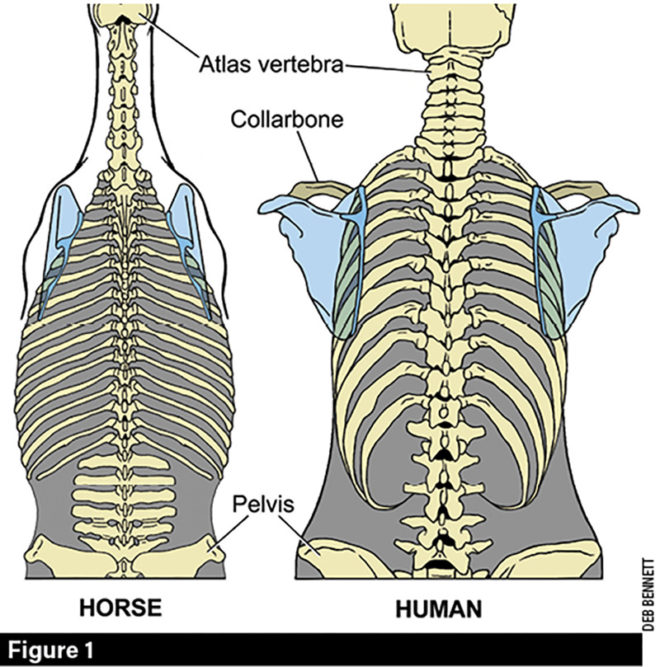
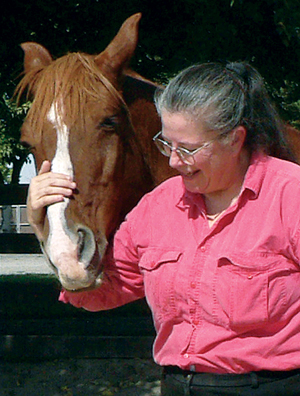






Post a comment
Report Abusive Comment